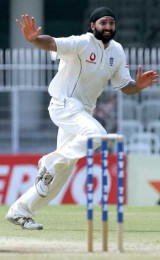Monty Panesar
Emma John
|
|

|
Half an hour after lunch on the final day of the Headingley Test, 24-year-old Panesar had administered the blow that would assure England's win over Pakistan, and with it the series. For Panesar, it was the most significant, and satisfying, moment of the summer. "On a pitch that's not renowned for spinners," he says, "I think bowling that sort of ball sticks in your mind."
Panesar was already a cult hero. As the first Sikh to play for England - in fact for any nation other than India - he had become an instant multicultural icon, a figure proclaiming a success for racial integration in fraught 21st-century Britain. As a deep fielder with the comic timing, if not the hand-eye co-ordination, of Robin Williams, he was lovingly mimicked by the crowds; here was a character to cling to while England's 2005 Ashes heroes retreated to the physio's table. As an orthodox left-arm finger-spinner he had, throughout the summer, shown patience and control as he gathered the wickets of some of the foremost players of spin in the world. But it was the ball to Younis that appealed to that deep yearning in every English fan's heart - here was a man who could ply magic.
Mudhsuden Singh Panesar was born on April 25, 1982, in Luton; his aunt's pet name for him, Monty, was the one that stuck. His father Paramjit, a carpenter, had migrated from India in the mid-1970s, and married a fellow-Punjabi, Gursharan; the family found community and a shared passion at Luton Indians Cricket Club. Panesar was ten when he first began to play, and Wasim Akram was his boyhood hero; another international leftarmer, Paul Taylor, remembered him bowling "horrible little seamers".
|
|
But the work ethic also took him to Loughborough for a computer science degree and, even when available, he found it hard to break into a Northamptonshire side that already had two established spinners, Graeme Swann and Jason Brown, both of whom had been to the fringe of the Test team and out again. Swann left the county before 2005, leaving the way clear for Panesar to come in halfway through the season when he graduated. He helped lift a winless side to the edge of promotion.
"Monty's a very special bowler," enthuses his county captain, David Sales. "He's got so much control. He becomes this very threatening, attacking spinner and gets drift and turn that's really unusual. It brings a different dimension to the game." Panesar finished that season with 46 Championship wickets in eight matches, and was a late call-up to the Indian tour. While his debut for England, in the First Test at Nagpur, will be remembered for the moment he trapped Sachin Tendulkar lbw as his first Test victim, for many the abiding image of that tour will be the hashed catch off Mahendra Singh Dhoni during the Third Test at Mumbai, when his arms seemed scarcely stapled to the rest of him. His batting was no more confident. His fallibility only added to his popularity with the public, if not with the England management.
But Panesar applied his dedication to both disciplines, to good effect. By the end of the summer, his bowling was simply too precious for most people to care about the rest. Five for 78 against Sri Lanka at Trent Bridge was the first sign; against Pakistan at Old Trafford, the promise of that five-for blossomed in an unexpectedly formidable bowling partnership with Steve Harmison. At Headingley, Panesar proved that he could continue to attack even when things were against him, and helped turn a 23-run deficit into an unlikely England victory.
In Australia he was seen as a potential match-winner, but again not with the decision-makers. England preferred a semi-fit Ashley Giles for the first two Tests and, by the time they were forced to relent amid a chorus of boos, the series was effectively gone. His eight wickets at Perth did him credit, but not the management. In the dressing-room, he keeps asking questions, anxious to learn. This is a quality that will help him emerge from the rubble of a failed series.

